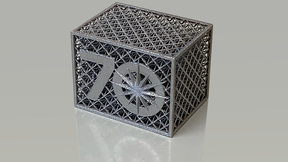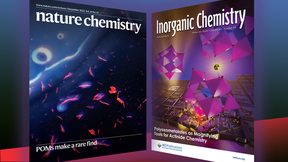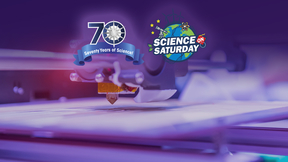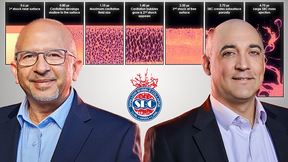Back
The nitrate runoff problem, a source of carcinogens and a cause of suffocating algal blooms in U.S. waterways, may not be a harbinger of doom. A new study led by the University of Illinois Urbana-Champaign and researchers from Lawrence Livermore National Laboratory (LLNL) demonstrates an approach for the integrated capture and conversion of nitrate-contaminated waters into…
A series of experiments conducted at the Omega Laser, part of the University of Rochester’s Laboratory for Laser Energetics, provide new insights into magnetic reconnection, a process that could help explain stellar flares and other astrophysical phenomena. The research confirmed that unstable ion-acoustic waves (IAWs) could be important to further understanding of the…
For Lynda Tesillo, Women’s History Month means more than reflecting on the past. Her path to Lawrence Livermore National Laboratory started with studying engineering at a university — a decision which put her in a unique position within her family. “We had limited resources growing up, particularly when it came to affording an education,” Tesillo said. “At the time, my…
A 170-page book featuring the Lawrence Livermore National Laboratory (LLNL) was recently published by the National Academies of Science, Engineering and Medicine, titled “Strategies to Renew Federal Facilities.” The publication describes methods to repurpose and restore infrastructure on federal properties, including the LLNL campus, which are tasked with providing…
The first peer-reviewed results from NASA’s Double Asteroid Redirection Test (DART) mission were published Wednesday by Nature, including contributions from LLNL’s planetary defense team. The DART spacecraft executed a successful hypervelocity impact of 150-meter asteroid Dimorphos on Sept. 26, 2022. Analysis by Earth-based telescopes determined that the impact…
Second in a series of articles describing the elements of Lawrence Livermore National Laboratory's fusion breakthrough. The National Ignition Facility (NIF) is the world’s biggest laser — three footballs fields could fit inside — but it’s what happened inside a capsule the size of a peppercorn that made scientific history on Dec. 5, 2022. The NIF experiment that produced…
Lawrence Livermore National Laboratory (LLNL) engineers and scientists have developed a method for detecting and predicting strut defects in 3D-printed metal lattice structures during a print through a combination of monitoring, imaging techniques and multi-physics simulations. The high-strength and low-density properties of metallic lattices have found applications in…
High-power lasers now create record-high numbers of electron-positron pairs, opening exciting opportunities to study extreme astrophysical processes, such as black holes and gamma-ray bursts. Positrons, or "anti-electrons," are anti-particles with the same mass as an electron but with opposite charge. The generation of energetic electron-positron pairs is common in extreme…
Studying radioactive materials is notoriously difficult due to their radiation-induced toxicity and risk of contamination when handling. The cost of the radioactive isotopes used in research also is a major barrier, with some costing more than $10,000 per microgram. Certain radioisotopes also cannot be produced in sufficient quantity so it is simply impossible for…
First in a series of articles describing the elements of Lawrence Livermore National Laboratory's fusion breakthrough. It was the middle of the night on Dec. 5, 2022, and anticipation was building among the handful of researchers and technicians in the National Ignition Facility (NIF) control room. A set of pre-shot simulations had predicted a slightly better than 50-50…
Who: Stan Hitomi, retired educator and district administrator for the San Ramon Valley Unified School District, will present “3D Printing: From Imagination to Realization” joined by a host of Lawrence Livermore National Laboratory (LLNL) scientists, including: Eric Duoss, Julie Mancini, Monica Moya, Dominique Porcincula, William Smith, Chris Spadaccini and Becca Walton…
New research led by Lawrence Livermore National Laboratory (LLNL) provides a better understanding of ejecta production, which has been the subject of broad interest for more than 60 years throughout the scientific community. Ejecta are particles of material forced out or ejected from an area. The phenomena are observed across many multi-disciplinary applications, including…
People afflicted with autoimmune diseases may someday receive help through treatments now under development by a Lawrence Livermore National Laboratory (LLNL) licensee and its’ collaborations with two major pharmaceutical companies. In late 2017, LLNL licensed a biomedical technology called nanolipoprotein particles (NLPs), which can deliver vaccines and drugs inside the…
Who: Lawrence Livermore National Laboratory (LLNL) scientist Jane Herriman will be joined by Tracy High School biology teacher Erin McKay to present “Supersizing Computing: 70 Years of HPC.” The event is the third lecture in the 2023 series of Science on Saturdays lectures showcasing “70 Years of Science” at the Laboratory. What: This presentation will discuss how the ever…
Lawrence Livermore National Laboratory’s (LLNL) National Ignition Facility’s (NIF) recent scientific advances, including the achievement of fusion ignition in December, have increased interest among aspiring young scientists for the NIF&PS Summer Scholar Program. “That’s kind of the cool thing about this past year,” said Patrick Poole, the program director. “We had so…
Who: Lawrence Livermore National Laboratory (LLNL) scientists Xavier Mayali and Ty Samo will be joined by Tracy High School biology teacher Erin McKay to present “Small Algae, Big World: The Impact of Microalgae on Global Carbon Cycling and Sustainable Biofuels.” The event is the second lecture in the 2023 series of Science on Saturdays lectures showcasing “70 Years of…
Lawrence Livermore National Laboratory (LLNL) employees, participating in five project teams, recently earned Department of Energy (DOE) Secretary’s Honor Achievement Awards. Representing some of the highest internal, non-monetary recognition that DOE employees and contractors can receive, the Secretary’s Honor Awards recognize DOE employees and contractors for their…
The Lawrence Livermore National Laboratory (LLNL) Discovery Center reopens to visitors on Feb. 1, after nearly three years of closure due to COVID-19. The Discovery Center’s reopening will feature facility renovations and a host of new exhibits related to the Laboratory’s research programs, institutional history and community role. Open to all ages, the Discovery Center…
A new software developed at Lawrence Livermore National Laboratory (LLNL), and known as Skywing, provides domain scientists working to protect the nation’s critical infrastructure with a high-reliability, real-time software platform for collaborative autonomy applications. The U.S. modern critical infrastructure — from the electrical grid that sends power to homes to the…
Ending with one of the most significant achievements in scientific history, 2022 will be remembered as an important year for Lawrence Livermore National Laboratory (LLNL). On Dec. 5, in the Lab’s 50th year of laser programs, LLNL’s National Ignition Facility (NIF) achieved fusion ignition for the first time in a laboratory setting: a reaction that produced more energy than…
























